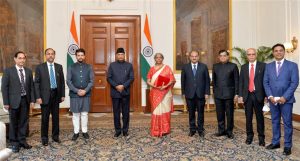By Vishal Nigam

New Delhi. 09 February 2021. Budget speeches are constrained by time and hence sectors missed out from the speech do not necessarily imply that they are less important. At a time when the world is devastated by COVID-19, the Finance Minister had clarity in highlighting relevant sectors. On Feb, 01 2021 defence economy was skipped from the speech and many pundits concluded that defence wasn’t her focus area despite having steered the ministry prior to being appointed as the Finance Minister.
The year 2020 has been unprecedented in many ways. While Covid impacted both the demand and supply side of the economy resulting in contraction like never seen before, the aggressive posture adopted by the Chinese across the Line of Actual Control (LAC) created high levels of uncertainty. Nirmala had an arduous task of balancing the criticality caused by the spread of pandemic with the criticality of the fault lines in which the Indian state resides.
Budget 2021-2022
She decided to direct her budget speech on health and infrastructure sectors to send a pointed message that her government was committed to both reducing the death trajectory caused by the pandemic and generate employment by building infrastructure and future assets. At the same time aware of the complexities in India’s defence capital acquisition procedure, she committed in her many post budget interactions that funds will be made available to the armed forces as and when required.
Capital Acquisition
On an average the armed forces spend $10 billion every year on capital acquisition. Taking a clue from the average spend, she allocated approximately $19 billion for FY22, benchmarked with RE for FY21; knowing very well that a large percentage of the allocation under Demand Number 20 will go towards meeting committed liabilities of previous years and not towards acquisition for FY22.
DEMAND NO 20
| FY20 (Actuals) | FY21(BE) | FY21 (RE) | FY22 (BE) |
| INR 111092 Cr | INR113734 Cr | INR134510 Cr | INR135060 Cr |
However during the year funds up to INR 2000 crores (almost $300 million) can be made available under the enhancement of financial powers for sanction of capital acquisition proposals, which came into effect in 2017. The 15th Finance Commission (2021-26) has also recommended a dedicated non-lapsable fund called the Modernisation Fund for Defence and Internal Security (MFDIS) to bridge the gap between budgetary requirements and allocation of capital outlay with an estimated corpus of INR 2.4lakh crore ($34 billion) over the period of five years (2021-26). While INR 1.5lakh crores ($20 billion) will be transferred to the Consolidated Funds of India, the rest will be generated from measures such as disinvestment of Public Sector Enterprises (PSEs) and monetisation of defence land.
Problem Area
If the recommendation of the 15th Finance Commission (2021-26) is agreed to, then the problem area for capital acquisition will not be as much availability of funds but the unscientific and protracted procedure laid down in Chapter II of Defence Acquisition Procedure (DAP 2020). While Chapter II of DAP 2020 is considered the soul of capital procurement, it has become its Achilles’ heel; year on year adversely impacting speed of acquisition resulting in armed forces acquiring older generation platforms.
Chapter II of DAP 2020 is flawed from Para 1 sub para (a), by committing the cardinal sin of giving license to line directorates of Service Head Quarters (SHQs) to seek Request for Information (RFI) from vendors to explore suitability of products available to meet their operational requirements.
It is incomprehensible that SHQs have to depend on the vendors to provide them data for acquisition to build across spectrum capability, a process extremely time consuming when the same information is freely available in ether.
RFIs aren’t a commitment for procurement and, timeline to process is neither indicated in Appendix L to Chapter II of DAP 2020. The entire process from sub para (a) to (c) is unaccounted and, the time from generating Statement of Case (SOC) to grant of Acceptance of Necessity (AON) could take as long as two years if not more. However, the proposed timeline for procurement which is 74 weeks to 106 weeks commences from the date of issue of the minutes of the meeting of Defence Acquisition Council (DAC) for issuance of AON and not from the time of floating the RFI.
Hence on a good day, the time line for capital procurement could at the very least be four years, which rarely happens and, by then the equipment being bid for has already become a few generations older.
Flags:
- What is the efficacy of RFI when information is available on fingertips and SHQs have the liberty of subscribing to data bases as well as utilising consulting services?
- How can SHQs justify the requirement of RFI to formulate ICDP, Request for Proposal (RFP) and Services Qualitative Requirements (SQRs)?
- Database and benchmarking price should be the responsibility of the directorates under IDS and SHQs and, relying on RFIs to benchmark pricing cannot be a valid justification.
Build capability on future generation platforms
Can any country trying to build across spectrum capability for its armed forces justify the protracted and unaccounted timelines to process RFIs? Certainly developing capability is not a function of whether the Finance Minister highlighted defence outlay in her budget speech but it is a function of resources available, efficient procedures and spends on Research and Development (R&D); all of which are critical areas today. While the 15th Finance Commission has recommended MFDIS, which to some extent will offset the issue of resources, spend on R&D by both government and the private sector remains a weak area. India’s Gross Expenditure on Research and Development (GERD) remains a paltry 0.7% of GDP and, spend on defence R&D is only a small fraction of GERD. Unless both the private and public sectors step-up spending on R&D and, Chapter II of DAP 2020 is amended to add efficiency in acquisition procedure, India would continue to build capability on older generation platforms rather than acquiring future generation platforms, which should be the stated aim of an emerging power.
Vishal Nigam Author of Dragon in the Air Transformation of Aviation Industry and the Airforce is a Delhi-based strategic analyst & an Indian Air Force veteran. The views in the article are solely the author’s. He can be contacted at editor.adu@gmail.com)


























































































































